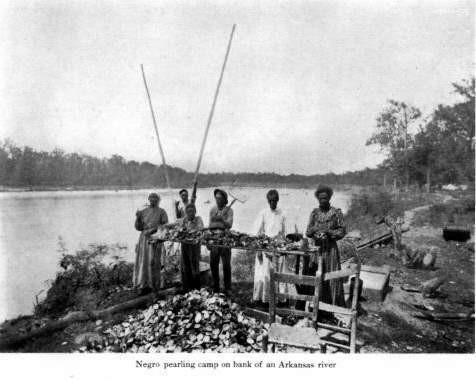|
Arkansas PearlsArkansas Pearls --The following historic information is from Kunz & Stevenson's book published in 1908. Be sure to research current laws in Arkansas before attempting pearling in Arkansas.
 Arkansas Pearling Camp
The next outbreak of pearling excitement was in Arkansas, in the region referred to by Daniel Coxe two centuries ago as the location of great pearl resources. Although in recent times little had been heard of pearls in Arkansas previous to 1895, they were not unknown in that state. For years Arkansas pearls had been picked up by the fishermen, and used as lucky stones or given to the children for playthings. Some had come into the possession of persons acquainted with their value. About 1875, a few Arkansas pearls were collected by a party of men engaged in cutting cedar poles on White River; in 1888, a brilliant pear-shaped pink pearl of twenty-seven grains was secured from the same river, and sold to a prominent resident. Little had been said about these finds, and in general the people of Arkansas had slight idea of the occurrence or the value of pearls in those waters. In 1895, a surveying party on White River found pearls in the Unios of that stream, and collected them to the value of about $5,000. News of this discovery attracted attention to the resource, and other persons sought for the gems in the White River and its tributaries in the St. Francis and the Arkansas rivers. The unusually low water in 1896 facilitated the fishery, and resulted in the discovery of many large and valuable gems. The interest developed rapidly, and within twelve months nearly every stream of water in Arkansas yielded pearls, with the finds most extensive and valuable in White River and its tributary the Black River, which has proved to be the richest pearling region in America. The industry centered at Black Rock, more than a thousand persons fishing within twenty miles of that place. It is estimated that within three years following the development of the fishery, this state yielded pearls to the value of more than $500,000. When Arkansas fishery was at its height, it was reported that ten thousand persons were employed therein. The fishermen were from nearly every class and condition in the state. Women were not absent; even children participated in the industry, and some proved more fortunate than the older hunters. It was not uncommon to see several hundred persons congregated at one bar or in one stretch of the river all intent on making a fortune, and all occupied in fishing or in opening the shells. So complete was the absorption of the people in this pursuit, and so many of the farm-hands were occupied in the eager search for anticipated fortunes, that the local papers reported much apprehension and difficulty in harvesting the cotton and other crops. It is interesting to note that in Arkansas a negro sold a very valuable pearl for a few dollars, under the persuasion of a white man, who, it is said, resold the pearl for nearly a hundred times more than what he paid for it. The local authorities investigated the matter; the case was brought to court, and the negro received a large advance in the price that had originally been paid him. Read more about Arkansas pearls.
Free Newsletter all about Pearls!
|






